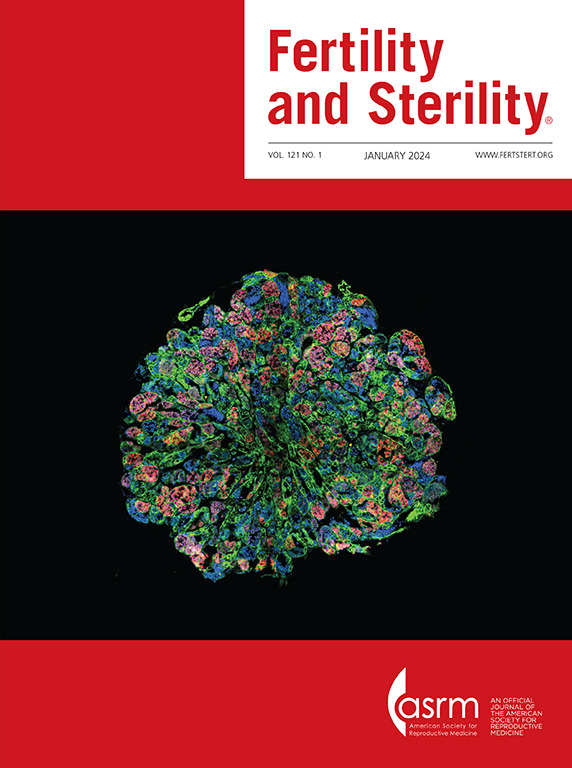体外受精中PGT-A对活产时间的影响。
IF 6.6
1区 医学
Q1 OBSTETRICS & GYNECOLOGY
引用次数: 0
摘要
目的探讨胚胎植入前基因检测非整倍体(PGT-A)是否会影响妊娠时间,从而导致活产。设计回顾性队列研究。美国单一、大型、大学附属的生育中心。受试者纳入2014年1月1日至2022年12月31日期间进行第一次卵母细胞提取的患者。根据首次取卵时PGT-A的使用情况,将患者分为PGT-A组和非PGT-A组。然后按年龄对患者进行分层:女性<38岁,女性≥38岁。使用9个标准进行倾向评分匹配,将2158名PGT-A患者与2158名非PGT-A患者在年轻年龄组中进行匹配,将1343名PGT-A患者与1343名非PGT-A患者在老年年龄组中进行匹配。PGT-A的暴露。主要结局指标:首次取卵后一年内导致活产的阳性妊娠率。这被用作成功怀孕时间的指标。结果在匹配过程中,PGT-A和非PGT-A患者的检查特征无统计学差异。Kaplan-Meier曲线显示,年轻组的活产概率无显著差异,全年活产风险比为0.97 (95% CI 0.90-1.04),但PGT-A患者的活产风险比明显较短,老年组的活产风险比为1.46 (95% CI 1.30-1.64)。在≥38岁年龄组中,使用PGT-A的患者在一年内的活产率高于未使用PGT-A的患者(51.2%对36.4%)。相比之下,<38岁年龄组的PGT-A和非PGT-A患者的累积一年活产率相似(69.5%对67.1%)。在两个年龄组中,PGT-A患者的流产率和平均转移次数较低。结论:pgt - a与38岁以上患者较短的妊娠时间导致活产相关,但不影响年轻患者一年以上的成功妊娠时间。本文章由计算机程序翻译,如有差异,请以英文原文为准。
The impact of PGT-A on time to live birth in IVF.
OBJECTIVE
To determine if utilizing pre-implantation genetic testing for aneuploidy (PGT-A) impacts time to pregnancy resulting in a live birth.
DESIGN
Retrospective cohort study.
SETTING
Single, large, university-affiliated fertility center in the United States.
SUBJECTS
Patients who underwent their first oocyte retrieval between January 1st, 2014, and December 31st, 2022, were included. Patients were categorized into a PGT-A group and a non-PGT-A group based on the use of PGT-A at the time of the first oocyte retrieval. Patients were then stratified by age: women <38 years old and women ≥38 years old at the time of the first retrieval. Propensity score matching was performed using nine criteria, matching 2,158 PGT-A patients to 2,158 non-PGT-A patients in the younger age group, and 1,343 PGT-A patients to 1,343 non-PGT-A patients in the older age group.
EXPOSURE
Use of PGT-A.
MAIN OUTCOME MEASURES
The positive pregnancy rate leading to a live birth over a one-year period following the initial egg retrieval. This was used as an indicator of time to successful pregnancy.
RESULTS
Following the matching process, there were no statistically significant differences in the examined characteristics between PGT-A and non-PGT-A patients. The Kaplan-Meier curves showed that there was no significant difference in the probability of having a live birth in the younger group, with a live birth hazard ratio for the full year of 0.97 (95% CI 0.90-1.04), but was significantly shorter for PGT-A patients, with a live birth hazard ratio of 1.46 (95% CI 1.30-1.64) in the older group. Patients in the ≥38 age group who used PGT-A had a higher live birth rate over a one-year period, compared to non-PGT-A patients (51.2% versus 36.4%). In contrast, PGT-A and non-PGT-A patients in the <38 age group had similar cumulative one-year live birth rates (69.5% versus 67.1%). In both age groups, miscarriage rates and mean number of transfers were lower for PGT-A patients.
CONCLUSION
PGT-A is associated with a shorter time to pregnancy resulting in a live birth for patients who are at least 38 years old but does not affect time to successful pregnancy in younger patients over a one-year period.
求助全文
通过发布文献求助,成功后即可免费获取论文全文。
去求助
来源期刊

Fertility and sterility
医学-妇产科学
CiteScore
11.30
自引率
6.00%
发文量
1446
审稿时长
31 days
期刊介绍:
Fertility and Sterility® is an international journal for obstetricians, gynecologists, reproductive endocrinologists, urologists, basic scientists and others who treat and investigate problems of infertility and human reproductive disorders. The journal publishes juried original scientific articles in clinical and laboratory research relevant to reproductive endocrinology, urology, andrology, physiology, immunology, genetics, contraception, and menopause. Fertility and Sterility® encourages and supports meaningful basic and clinical research, and facilitates and promotes excellence in professional education, in the field of reproductive medicine.
 求助内容:
求助内容: 应助结果提醒方式:
应助结果提醒方式:


